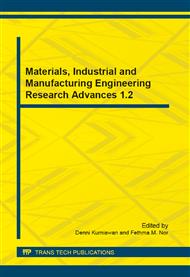p.3
p.9
p.15
p.19
p.25
p.29
p.35
p.41
InSe Nanothin Film with Ar-Gas Low Vacuum Pressure
Abstract:
InxSe1-x (x = 0.4, 0.5, 0.6) thin films are deposited at room temperature on glass substrates with thickness ~500nm by thermal evaporation technique. The X-Ray diffraction analysis showed that both the as-deposited films In2Se3 and InSe (x= 0.4 and 0.5) are amorphous in nature while the as-deposited film In3Se2 is polycrystalline and the values of energy gap are Eg=1.44eV for In2Se3, Eg=1.16eV for InSe and Eg=0.78eV for In3Se2. The same technique used with insert Argon gas at pressure 0.1 mbar where InxSe1-x (x = 0.4, 0.5, 0.6) thin films are deposited at room temperature on glass substrates with thickness ~100nm. The X-Ray diffraction analysis showed that the as-deposited films In2Se3 are amorphous in nature while the as-deposited film InSe and In3Se2 are Nanocrystalline with grain size 33nm and 55nm respectively and the values of energy gap are Eg=1.55eV for InSe and Eg=1.28eV for In3Se2. The energy gap of InSe thin films increase with Argon gas assist and phases changes from amorphous and polycrystalline to nanostructure material by thermal vacuum deposition technique.
Info:
Periodical:
Pages:
15-18
Citation:
Online since:
August 2014
Authors:
Keywords:
Price:
Сopyright:
© 2014 Trans Tech Publications Ltd. All Rights Reserved
Share:
Citation:


